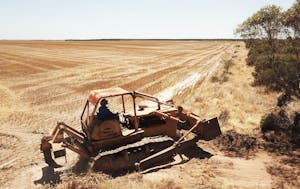When 13-year-old Will Carmody’s dad, Laurie, bought the family’s first piece of machinery for his new farm he and his three brothers jumped in the ute and raced to see it coming off the drop deck trailer.
 It was 1976- and there was great excitement. Until then they’d relied on war clearance stock, one straight from the Guadalcanal campaign 30 years before.
It was 1976- and there was great excitement. Until then they’d relied on war clearance stock, one straight from the Guadalcanal campaign 30 years before.
“Dad had bought a brand new Komatsu D60-6 bulldozer and from the moment I saw it, it was mine,” Will recalls.
“My older brothers never stood a chance.”
The Carmody’s were already fifth generation farmers, buying and clearing vast new blocks of West Australian land, moving progressively eastward from the Swan Valley as the clan expanded.
Orderly succession has always been part of their plan, ensuring there is sufficient working property to meet the family’s financial needs.
In what was then far flung Esperance on the broad acres south east of Perth, Will went to the school of the air, rushing through his studies in the morning so he could spend his afternoons on the brand new yellow bulldozer with its 12litre 155hp Cummins diesel.
“It was a huge carrot, but it also contributed to me learning so much about farming and to appreciating the land and the bush,” Will said.
The Komatsu D60 is enshrined as one of the most versatile pieces of machinery of its time and the Carmodys then as now, were masters of multi-tasking.
In the hands of Laurie, Will and his brothers when they got the chance, it cleared land, dug dams, worked on vermiculite and gypsum mining, fought bush fires and, fitted with new attachments, ploughed. It was even craned on to a ship to move grain cargo.
By the time the next generation got to drive it, it had 14,500hours up and the family had expanded to three wheat, barley and canola farms in the area totalling about the same number of hectares.
Tom, Will’s nephew, was 13 too when he was first allowed to drive it on bush tracks between properties never using the implements but learning its feel. It helped that the D60 was ahead of its time with full hydraulics which made clutch and brake application easier for a young bloke.
Just after the turn of the century the steering stopped working, a victim, the Carmodys thought of their using it for ploughing, round and round in one direction. It stopped working on the farthest edge of their landholding and they backed and filled it 200 metres into a convenient shed and that’s where it rested until recently.
In the meantime they’d bought a Komatsu PC300-8 for digging drains when the water table began to rise, sold it when the job was done and bought a KomatsuWA320-5 wheel loader for general farm duties. As always, they shared the machinery across all properties.
Then they bought a cattle station 1000km north, at Wiluna on the edge of the Caning Stock Route, running 3500 Short Horn cross and Hereford breeders. There were roads to be built and land to be cleared – obviously under more stringent guidelines than existed 40 years before.
Tom and his cousin Caleb went to the shed and found the D60 still filled with fuel and oil.
“We installed some new batteries, hit the decompression lever and she started first time,” Tom said. “The steering clutches even appeared to be working, but then they failed so we had to tow her in.”
A Komatsu mechanic from Kalgoorlie 400kms away had completed his apprenticeship on the D60 in South Africa and took on a special project to discover what could be done to undertake a normal repair – not a restoration, just a repair.
To the Carmody’s amazement every replacement part specified on the mechanic’s list, with the exception of two, was in stock in Kalgoorlie and the others could be freighted quickly from the east coast.
They trucked the D60 to Kalgoorlie, waited six weeks while the work was done- all with Komatsu Genuine Parts (“it could have been faster but there was a bit of love involved”) and then bought it back mid-harvest.
“So far there’s just been time for a quick drive,” Tom said when it returned. And Will, harvesting on his property, had been able to do no more than give it a glance.
“From a strictly economic perspective it’s been a good deal,” Tom said. “It’s cost around $22,000 all up and that includes my time and the freight costs. You couldn’t replace it for anything near that -and there’s a lot of productive hours left in it.”
The D60 is soon to make the long haul to Tom’s dad Tim, mother Louise and younger brother Jack, who are running Prenti Downs at Wiluna.
But before it goes, there was a rite of passage still to be undertaken.
Will’s son Robbie, at school in Perth, had to come home for the holidays to become the fourth generation to drive it. In honour Will was considering giving the D60 a completely fresh paint job- its first in 42 years.